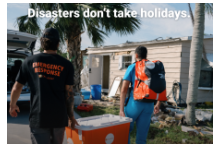Direct Relief: Because disasters don’t take holidays.
Every day, communities across the U.S. and around the world face emergencies that threaten their health, safety, and stability. For people already experiencing the greatest challenges, a disaster can be especially devastating — and recovery can take far longer. Direct Relief works to change that.
Direct Relief is a humanitarian organization improving the health and lives of people affected by poverty or emergencies — without regard to politics, religion, or ability to pay. Active in all 50 U.S. states and more than 100 countries, Direct Relief equips healthcare professionals and community organizations with the resources they need before, during, and after disasters.
This year, Direct Relief ranked No. 5 on Forbes’ America’s Top 100 Charities list with a perfect 100% fundraising-efficiency rating. Charity Navigator also awarded Direct Relief an overall 100% score for 2025 — marking its 15th consecutive Four-Star rating.
Direct Relief pre-positions essential medical supplies in areas most vulnerable to hurricanes, wildfires, floods, and other climate-driven events so help is ready the moment it’s needed. When disasters strike, the organization responds quickly. In the last five years alone, Direct Relief has responded to nearly 50 U.S. emergencies, delivering critical medicines, medical gear, and support for frontline healthcare teams.
The organization also supports long-term recovery by strengthening medical infrastructure and helping clinics rebuild so communities can regain stability. A nationwide network of nearly 5,000 healthcare providers relies on this support, many located in regions with high FEMA disaster-risk scores, where the need for consistent, accessible care is greatest.
This GivingTuesday is an opportunity to stand with communities facing crisis. By supporting Direct Relief, you help reinforce emergency preparedness, expand access to essential medicines, and ensure that when disasters happen, care is already on the way. Together, we can make sure the people most affected are never left behind — and that essential health services remain available whenever and wherever they’re needed.
